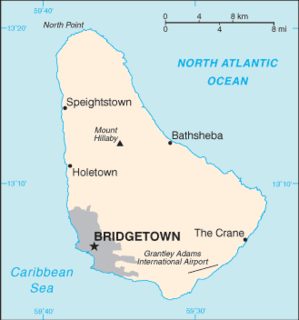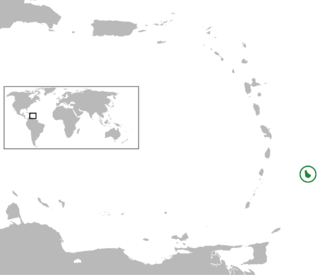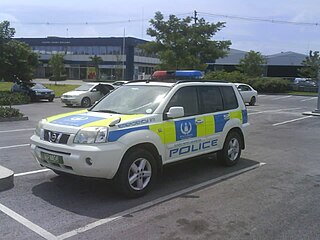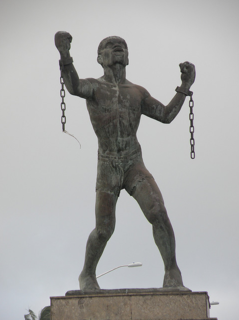Related Research Articles

Barbados is an island country in the Lesser Antilles of the West Indies, in the Caribbean region of the Americas, and the most easterly of the Caribbean Islands. It occupies an area of 432 km2 (167 sq mi) and has a population of about 287,000. Its capital and largest city is Bridgetown.
Barbados is an island country in the southeastern Caribbean Sea, situated about 100 miles east of Saint Vincent and the Grenadines. Roughly triangular in shape, the island measures some 21 miles from northwest to southeast and about 14 miles from east to west at its widest point. The capital and largest town is Bridgetown, which is also the main seaport.

Bridgetown is the capital and largest city of Barbados. Formerly The Town of Saint Michael, the Greater Bridgetown area is located within the parish of Saint Michael. Bridgetown is sometimes locally referred to as "The City", but the most common reference is simply "Town". As of 2014, its metropolitan population stands at roughly 110,000.

Barbados is a continental island in the North Atlantic Ocean and is located at 13°10' north of the equator, and 59°32' west of the Prime Meridian. As the easternmost isle of the Lesser Antilles in the West Indies, Barbados lies 160 kilometres (100 mi) east of the Windward Islands and Caribbean Sea. The maritime claim for Barbados is a territorial sea of 12 nmi, with an exclusive economic zone of 200 nmi which gives Barbados a total maritime area of 186,898 km2 (72,162 sq mi). Of the total EEZ area, 70,000 km2 is set aside for offshore oil exploration. A pending application to UNCLOS has placed for consideration a continental shelf 200 nmi to the east and south. To the west, most of Barbados' maritime boundaries consist of median lines with neighbours. These neighbours include: Martinique, and Saint Lucia to the northwest, Saint Vincent and the Grenadines to the west, Trinidad and Tobago and Venezuela to the southwest, and Guyana to the southeast.
The music of Barbados includes distinctive national styles of folk and popular music, including elements of Western classical and religious music. The culture of Barbados is a syncretic mix of African and British elements, and the island's music reflects this mix through song types and styles, instrumentation, dances, and aesthetic principles.

The country of Barbados is divided into sub-regions known as parishes.
Speightstown, also known as Little Bristol, is the second largest City centre of Barbados. It is situated 12 miles (19 km) north of the capital city of Bridgetown, in the northern parish of Saint Peter.

Holetown, is a small city located in the Caribbean island nation of Barbados. Holetown is located in the parish of Saint James on the sheltered west coast of the island.

The parish of Saint James is an area located in the western central part of the country of Barbados. Increasingly St. James is becoming known as the playground of the rich and famous, and as a haven for sun-starved tourists with its up-market hotel resorts.

The Parish of Saint Peter is one of eleven parishes in the Caribbean island country of Barbados. It is named after the Christian Apostle and patron saint, Saint Peter. It is located in the north of Barbados, and is the only parish besides Saint Lucy that extends from the east coast to the west.
A tuk band is a kind of Barbadian musical ensemble, which plays tuk or rukatuk music. They consist of a double-headed bass drum, triangle, flute and a snare drum; the traditional fiddle has most recently been replaced by the pennywhistle. The tuk band is based on the regimental bands of the British military, which played frequently during the colonial era. The Tuk Band is accompanied by characters that are African in origin. African tribes used costumed figures to represent elements such as fertility, witch doctors, and describing routes of commercial transportation, as well as having survived difficult times.

The culture of Barbados is a blend of West African and British cultures present in Barbados. English is the official language of the nation, reflecting centuries of British influence, but the Bajan dialect in which it is spoken is an iconic part of the Barbadian culture. This dialect is a combination of the languages from the different inhabitants in its history.

The following is an alphabetical list of topics related to the nation of Barbados.

The Barbados Police Service (BPS), previously called the Royal Barbados Police Force (RBPF), is the law enforcement agency in Barbados, as established under the Police Act, Cap. 167. Richard Boyce is currently Commissioner of the Police.
White Barbadians or European Barbadians are Barbadian citizens or residents of European descent. The majority of European Barbadians are descended from English, Portuguese, and Scottish settlers and Irish indentured servants and settlers, who arrived during the British colonial period. Other European groups consisted of the French, Germans, Austrians, Spaniards, Italians, and Russians. In addition, some of those considered to be European Barbadians are of partial European ancestry and vice versa. CIA World Factbook estimates that there are some 20,000 white Barbadians in the country.
Barbadian British people, Bajan Brits or British Barbadians, are citizens or residents of the United Kingdom whose ethnic origins lie fully or partially in the Caribbean island of Barbados. The UK is home to the second largest Barbadian-born migrant population out of all the OECD countries, with the 2001 Census recording 21,601 UK residents born on the Caribbean island, compared to the 53,785 Barbadian-born residents of the United States.

The historical ties between the governments of Barbados and the United Kingdom of Great Britain and Northern Ireland (UK) are long and complex, including settlement, post-colonialism and modern bilateral relations. The two countries are related through common history spanning 339 years (1627–1966). Since the Barbadian date of political independence, these nations continue to share ties through the Commonwealth of Nations. Until becoming a Commonwealth republic in 2021, Barbados also shared the same Head of State, with Queen Elizabeth II as their Monarch.

Black Barbadians or African Barbadians are Barbadians of entirely or predominantly African descent.
Sir James Drax was an English planter in the colonies of Barbados and Jamaica. Born in England, Drax travelled to the English colony of Barbados, acquiring ownership of several sugar plantations and a number of enslaved Africans. Drax was expelled from Barbados by Royalists due to being a Parliamentarian, though he returned in 1651 when the island was returned to Parliamentarian control. Drax returned to England where he died in 1662. He would go on to establish a dynasty of wealthy slave owning sugar planters.
References
- ↑ "Sights & Attractions in Barbados". Fodor's. 2008-12-31.
Without question, Barbados is the "most British" island in the Caribbean.
- ↑ "Country profile: Barbados". New Internationalist. 2008-12-31.
Coastal resorts have names like Hastings and Worthing; inland villages called Highgate and Clapham are redolent of London suburbia. Nicknamed either affectionately or disparagingly 'Little England', this is the most British of the Commonwealth Caribbean islands.
- ↑ "Speightstown Esplanade: Home Of Back In Time Pan 2008". The National Cultural Foundation (NCF). 2008-12-31.
Speightstown derived its name from its location on the land of William Speight, a wealthy and influential merchant who later became a member of the island's first parliament under Governor Henry Hawley in 1639. On the island's first map, drawn by one of the country's earliest settlers, Captain John Swan, around 1640, the area was shown as "Spykeses Bay" and many Barbadians have pronounced it "Spykestown" ever since. The town was a bustling seaport, and for many years, and carried on such a thriving trade with Bristol in England that it called "Little Bristol".
- ↑ "Holetown at TotallyBArbados.com". TotallyBarbados.com. 2008-12-31.
Holetown was the first town in Barbados, and was discovered in 1625 by an Englishman called Henry Powell, who was blown off course and discovered Barbados by accident. He returned to Barbados two years later in 1627 with a group of English settlers who named the area as Jamestown after the then king of England James 1st.